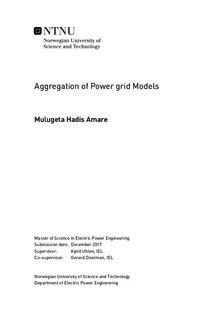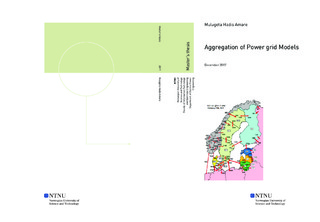| dc.description.abstract | In recent days, energy demands are growing rapidly. To meet this demand rise, several distributed energy sources and power generations are adding to the existing power system network. At the same time, cross-country and continental interconnections are becoming attractive investments due to a high share of renewable energy sources, mainly wind and solar. This increases the physical size as well as network data of the power system model. Consequently, monitoring and studying such a very large power system model becomes more challenging and complex task. Therefore, it is neither practical nor necessary to use the complete and detailed grid models. As a result, the need for aggregated models has been driven by several reasons in analyzing and monitoring the grid data. Limitation of time, memory and power to run the complete model, and accessibility of network data are some critical reasons. The execution time of such a big power system model may exceed the required time in short-term decisions while studying the stability, system planning, and market analysis.
One practical approach to overcome these problems is, to replace less important parts of the grid by an equivalent model for a specified acceptable tolerance of model aggregation. Depending on the clustering techniques and the intended use of the equivalent model, power grid aggregations are divided into static and dynamic aggregations. Both the available static and dynamic power grid aggregation methods are studied in this report and case studies have been accomplished in a commercial simulation tool called Power System Simulator for Engineering (PSSE) using Python scripts.
In the first case study of this project, an automation based on Python scripts has been developed to aggregate some part of the Norwegian grid model targeting on the low voltage parts of the grid and the static aggregations were performed based on voltage levels. The equivalent parameters of the aggregated models are determined to preserve the steady state results of the generator and load buses in the same voltage ranges. The targeted area containing 82 buses with a base voltage less than 66 kV has been aggregated into four generator bus system. The equivalent steady state power flow solutions of the aggregated model showed that this methodology can be applied to simplify grid models used for power flow studies and market analysis. Since this method doesn t take into account any dynamics, these aggregated models cannot be used to accurately preserve the dynamics of the system during stability studies. Due to the challenges to fix the parameter configuration problems of user-defined models in such a big case study, the Norwegian grid, a dynamic aggregation has been studied in another smaller power system model.
To emphasize on how to preserve system dynamics, an aggregation methodology based on coherency identification has been applied to IEEE 24 bus test and reliability system. Since coherent groups are made based on their dynamic response this methodology gives better dynamic equivalent models which can be used for stability studies. The coherent groups of a given system differ based on the type, location, severity and duration of the system disturbance under consideration. The coherency level of the machines will also depend on the type of fault initiated during the stability study. This makes the aggregation difficult to form one unique dynamic equivalent model that can be used to maintain the dynamics of each machine in the coherent group. The impact of these scenarios in determining the coherency of machines has been investigated by considering a three-phase bus and a line to ground faults. The dynamic equivalent models of the case study, following these disturbances, are developed together with their network parameters and dynamic simulation results. Most machines respond coherently during the three-phase fault and hence the case study, which originally contained 24 buses, has been aggregated into two generator bus system. Whereas in case of a line fault, the dynamics of the machines differ and the coherent groups are increased resulting in an equivalent model containing six generator buses. | |

